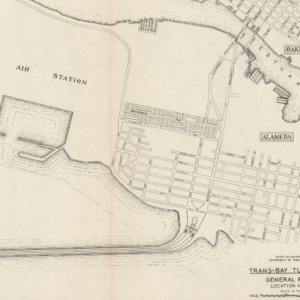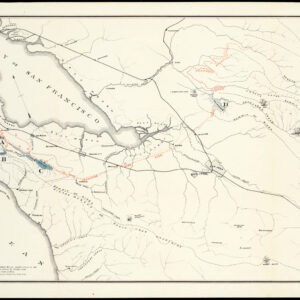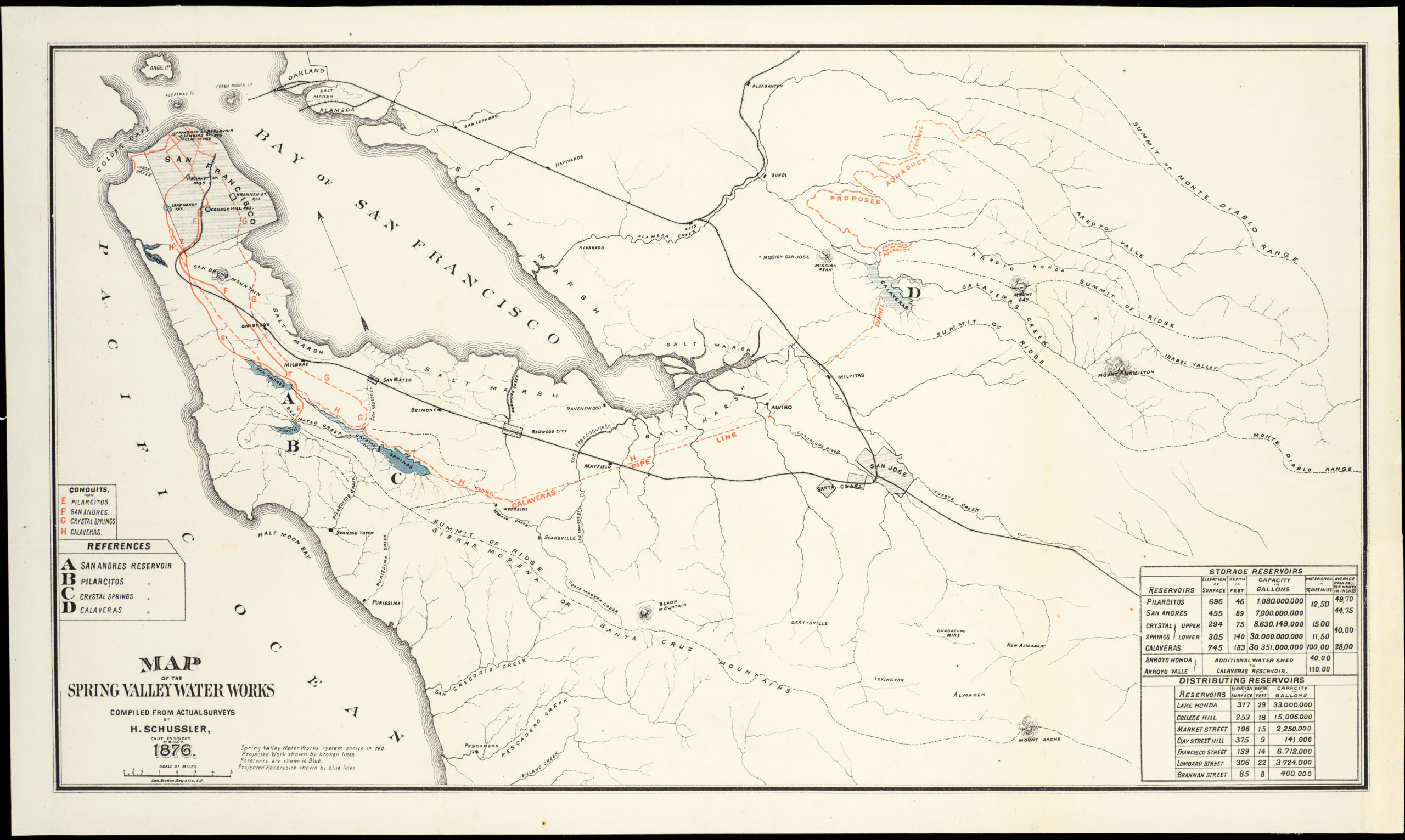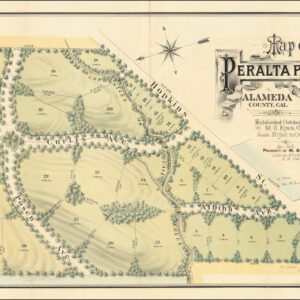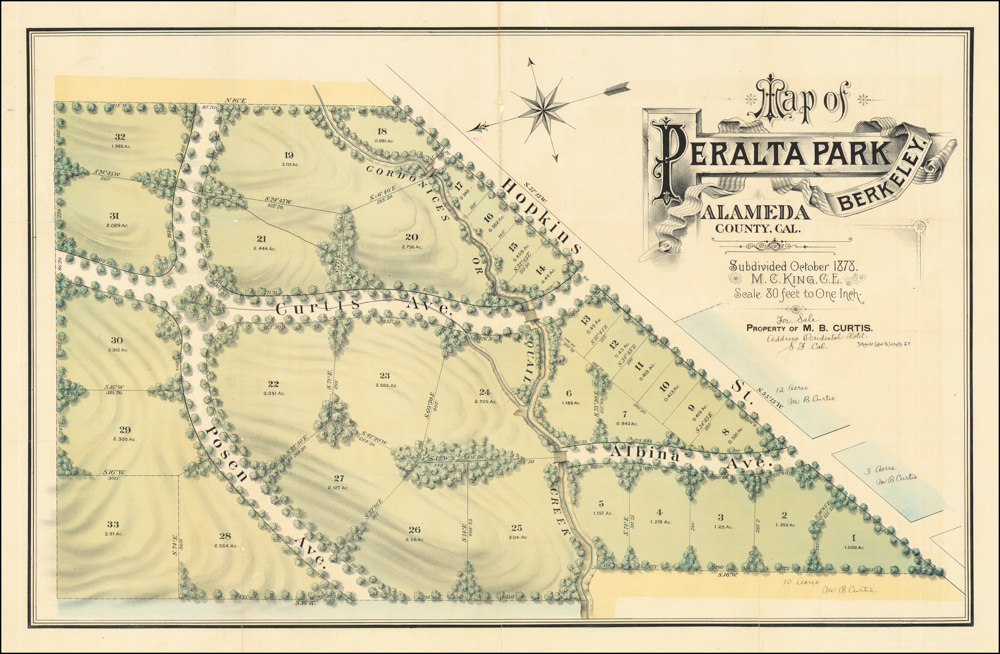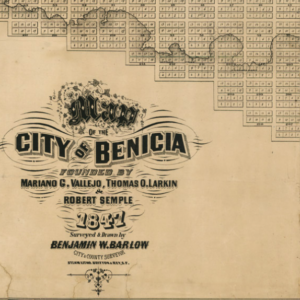The first official town plan of Vallejo.
Map of the City of Vallejo, terminus of the Napa Valley, Sonoma Valley and California Pacific Railroad.
$4,500
1 in stock
Description
A rare map showing John Frisbie’s vision for Vallejo.
This exciting 1868 cadastral Map of the City of Vallejo is a historically significant document that captures the urban layout and developmental aspirations for this new settlement in the Bay Area. This map was surveyed by E.H. Rowe, a San Francisco-based civil engineer presumably employed by the city, and published by the iconic printers Britton & Rey to showcase Vallejo’s strategic position as the northern terminus of key railroad lines. A well-organized township, enhanced by modern infrastructure and proximity to San Francisco, caused Vallejo to attract investors and settlers alike quickly. These newcomers would rely on cadastral maps and auctions to acquire their stake in this rapidly developing city.
The map highlights Vallejo’s planned grid system, an urban layout championed by John B. Frisbie, widely regarded as the city’s founder. As the map shows, the orthogonal planning allowed the town to be developed in coherent stages. This is seen in the central part of the new town, which is set at an angle to the rest of the city despite retaining the orthogonal layout. For most urban sprawl, streets running east-west were named after individual states, while those running north-south were named after California counties. This deliberate division reflected the founders’ homage to the nation and the state. The layout also underscores Vallejo’s ambitions as a hub for transportation and commerce through its connection to emergent rail networks and its proximity to the waterfront.
Among the map’s key features, we find the California Pacific Railroad prominently displayed, emphasizing Vallejo’s role in linking the agricultural regions of Napa and Sonoma Valley to the broader Bay Area. The railroad lines run parallel to the waterfront, underscoring their importance for personal mobility, regional connectivity, and transporting goods. Along the Strait of Carquinez waterfront, eight distinct wharves are shown, confirming Vallejo’s status as a port town with substantial maritime activity. At least four of these are new freight wharves. These are connected to the town’s rail infrastructure, revealing how important the docks were in facilitating trade and the movement of goods. A large wharf furthest to the southeast is dedicated to passenger traffic.
Our map also features the Telegraph Road to Benicia, which follows the route of Colonel Stockton’s telegraph line established in 1867. This road provided a vital communication link between Vallejo and the nearby city of Benicia, founded in 1846.
The map initially served a dual purpose: On one hand, it was a practical guide to one of the Bay Area’s new emergent towns, and on the other, it was meant as a promotional tool to attract settlement and spur real estate development. This aligns smoothly with Frisbie’s efforts to attract people and investors to the new town. By illustrating its grid plan, strategic rail and maritime connections, and modern infrastructure, Vallejo appealed to investors and settlers during a rapid expansion in California.
The map is oriented with the north positioned toward the upper left corner. A printed annotation in the lower left part of the map announces an auction sale of plots scheduled for September 21, 1868, at the salesroom of John Middleton & Son. This confirms that our example constitutes the rarer second variant of this map (see Census section below). A text in the lower left corner – present on all examples of this map – provides data on street and plot dimensions.
Vallejo soon became a vital node in Northern California’s rapidly growing networks of commerce and infrastructure, and the map is a testament to the town’s aspirations as a hub of transportation and economic development.
Context is Everything
New towns of the Bay Area
This 1868 map of Vallejo reflects a transformative era in California’s history, marked by rapid settlement, infrastructure development, and economic expansion. Situated in the northern San Francisco Bay Area, Vallejo’s growth was shaped by strategic planning, transportation advancements, and its role in the state’s urban and economic integration.
Vallejo’s origins trace back to the Rancho Suscol, an 84,000-acre Mexican land grant awarded General Mariano Guadalupe Vallejo in 1844. Vallejo played a key role in regional governance under Mexican rule, but the U.S. annexation of California in 1848 reshaped the region’s political and economic landscape. The Gold Rush accelerated settlement, attracting thousands of prospectors and settlers who spurred the rapid establishment of towns across the Bay Area. The influx of people underscored a necessity for urban planning and infrastructure to support the growing populations, which paved the way for Vallejo’s development.
During the mid-19th century, Northern California saw intense competition among emerging towns vying for prominence. Cities like Sacramento and Benicia briefly served as state capitals, leveraging their strategic locations to attract investment. Vallejo followed a similar trajectory, benefiting from its position at the mouth of the Napa River and its proximity to trade routes. The establishment of the Mare Island Naval Shipyard in 1854 cemented its economic importance, positioning the city as a key hub for shipbuilding and maritime trade.
John B. Frisbie’s Vision for Vallejo
John B. Frisbie, General Vallejo’s son-in-law, spearheaded Vallejo’s urban development. Leveraging control of the land grant, Frisbie meticulously planned the city’s layout, with streets named after U.S. states and California counties. The city’s design emphasized accessibility and order, aligning with contemporary urban planning trends. Frisbie also prioritized connectivity, ensuring Vallejo’s role as the northern terminus of the California Pacific Railroad, which linked the city to Napa and Sonoma Valleys and expanded its reach as a center for rail and maritime commerce.
The production of the 1868 map coincided with a broader push among Bay Area towns to attract settlers and investment. Railroads revolutionized regional economies, connecting the agricultural areas of the interior with San Francisco and the Bay Area, thus enhancing Vallejo’s strategic significance. The map highlights Vallejo’s rail terminus, wharves, and other infrastructure designed to position the city as a vital trade gateway.
Emerging from the vision of John B. Frisbie and bolstered by the latest transportation innovations, the map captures Vallejo’s aspirations as a planned urban center of strategic importance. It offers valuable insight into the ambitions of a young city poised for growth.
Census
The Map of the City of Vallejo has two variants, both published by Britton & Rey in 1868. The distinction between the two variants consists of an additional printed advertisement along the bottom of the recto, associating the map with an upcoming real estate auction scheduled for September 21, 1868, at the salesroom of John Middleton & Son.
Both variants are rare and increasingly difficult to find on the open market. The OCLC lists three institutional examples of the original version without the auction information: the Huntington Library, Bancroft Library (UC Berkeley), and UC Davis (OCLC no. 84012492). To our knowledge, Yale University Library is the only institutional holding of Neatline’s variant, which includes the auction advert.
Cartographer(s):
Britton & Rey (1852 – 1906) was a lithographic printing firm based in San Francisco and founded by Joseph Britton and Jacques Joseph Rey in 1852. Especially during the second half of the 19th century, Britton and Rey became the leading lithography firm in San Francisco, and probably California. Among their many publications were birds-eye-views of Californian cities, depictions of the exquisite landscapes, stock certificates, and no least maps. While Rey was the primary artist, Britton worked not only as the main lithographer but was essentially also the man running the business. In addition to their own material, the firm reproduced the works of other American artists like Thomas Almond Ayres (1816 – 1858), George Holbrook Baker (1824 – 1906), Charles Christian Nahl (1818 – 1878), and Frederick August Wenderoth (1819 – 1884). Following Rey’s death in 1892 Britton passed the form on to Rey’s son, Valentine J. A. Rey, who ran it until the great earthquake and fire of 1906 destroyed most of the company’s assets.
Joseph Britton (1825 – July 18, 1901) was a lithographer and the co-founder of the prominent San Francisco lithography studio Britton and Rey. He was also a civic leader in San Francisco, serving on the Board of Supervisors and helping to draft a new city charter. In 1852, he became active in lithography and publishing, first under the name ‘Pollard and Britton,’ and then ‘Britton and Rey,’ a printing company founded with his friend and eventual brother-in-law Jacques Joseph Rey. Britton and Rey became the premier lithographic and engraving studio of the Gold Rush era, producing letter sheets, maps, and artistic prints.
Jacques Joseph Rey (1820 – 1892) was a French engraver and lithographer born in the Alsatian town of Bouxwiller. At the age of about 30, he emigrated to America, eventually settling in California. Here, he soon entered into a partnership with local entrepreneur and civic leader Joseph Britton. Three years later, Rey also married Britton’s sister, allowing his business partner and brother-in-law Britton to live in their house with them. Rey and Britton were not only an important part of the San Francisco printing and publishing scene but also owned a plumbing and gas-fitting firm. In the early years, both men would sometimes partner up with others on specific projects, but by the late 1860s, their partnership was more or less exclusive.
E.H. RoweE.H. Rowe was a civil engineer and surveyor active in the Bay Area during the middle of the 19th century. Not much is known about him, but we can assemble some information from various survey maps of the period.
Warren Heckrotte notes that in 1849, the Alta California newspaper mentions E.H. Rowe as the surveyor of Parker House. This was among San Francisco’s most renowned hotel and gambling establishments at the time. In 1850, however, the Parker House was replaced by the Jenny Lind Theatre, which, after being destroyed in the fires of 1851 and subsequently rebuilt, was purchased by the City of San Francisco in 1852 for use as the city hall.
In light of this, and his involvement in several key maps of the period (e.g. Map of the Rancho del Cañada de Capay, in the county of Yolo, Alta California from 1854), we assume that he served in an official surveying capacity for the City of San Francisco.
Condition Description
Backed on new linen with minor loss.
References
